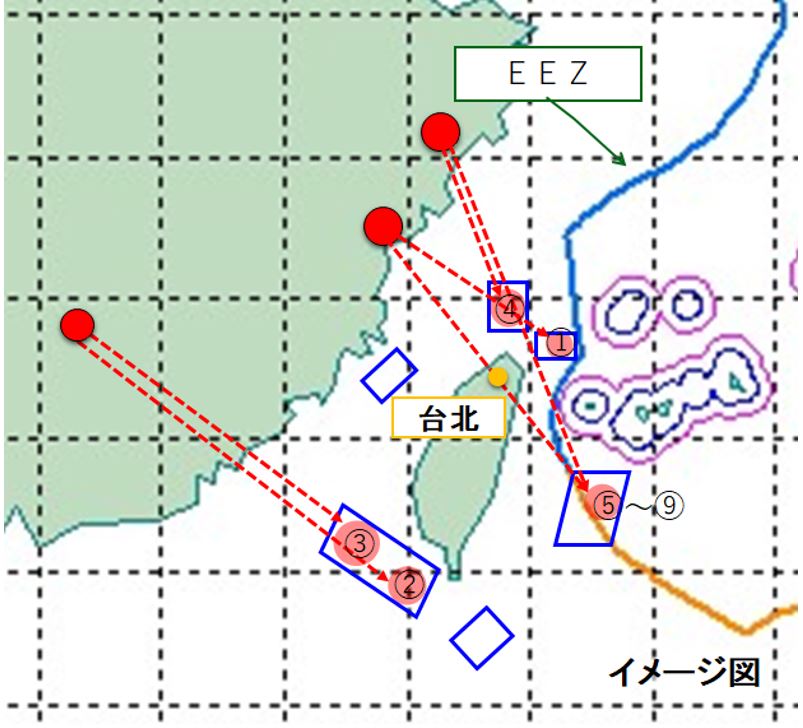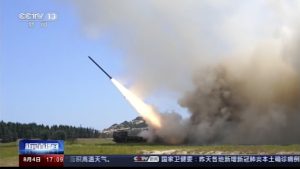Japan’s Defense Minister Kishi Nobuo said on August 4 that the Chinese military launched five ballistic missiles into Japan’s exclusive economic zone (EEZ) during a massive military drill aimed at Taiwan, prompting Tokyo to lodge a diplomatic protest with Beijing.
The incident marked the first time any ballistic missile belonging to the Chinese military had landed within the Japan’s EEZ.
“This is a grave issue that concerns our country’s national security and the safety of the people,” Kishi told reporters at night on the same day.
China’s People’s Liberation Army began live-fire military exercises in six air and sea areas around Taiwan on August 4. The military exercise area included a zone just 60 kilometers from Yonaguni Island and Hateruma Island in Japan’s Okinawa Prefecture, spreading tensions over Taiwan to Japan.
“Since China and Japan have not yet carried out maritime delimitation in relevant waters, China does not accept the notion of so-called Japanese EEZ,” China’s Foreign Ministry spokesperson Hua Chunying said on August 3, the day before the planned exercises began.
From a Japanese point of view, it is apparent that China is taking advantage of U.S. House Speaker Nancy Pelosi’s visit to Taiwan to increase its military presence and security influence in areas surrounding Taiwan and Japan, in a move to make yet another unilateral attempt to change the status quo. It also drives home the point Japanese officials have been making in recent years that any crisis in the Taiwan Strait would necessarily have a severe impact on Japan’s security.
According to the Japanese Defense Ministry, China fired a total of nine ballistic missiles from China: five from the coast of Fujian province, two from the coast of Zhejiang province, and two from the inland area of China, between around 3 p.m. and shortly after 4 p.m. in Tokyo time. Out of those missiles, five fell within the Japanese EEZ to the southwest of Hateruma Island in Okinawa. Those missiles flew between around 350 kilometers and 700 kilometers, the ministry said. In addition, one missile landed outside Japan’s EEZ to the north-northwest of Yonaguni Island in Okinawa.

A map provided by the Japanese Ministry of Defense shows the trajectory of nine missiles launched from China in military drills on Aug. 4, 2022.
The Japanese Defense Ministry said the Japanese Self-Defense Forces will continue to do their utmost to collect and analyze information and to conduct warning and surveillance activities. It has not disclosed specific operations of the SDF, but it is widely believed among military experts in Tokyo that Maritime Self-Defense Force (MSDF) ships and maritime patrol aircraft, among others, have taken measures to prepare for necessary countermeasures in times of emergency in waters close to Japan.
The national broadcaster NHK reported on August 4 that the Air Self-Defense Force scrambled its F15 fighter aircraft at least six times from the morning to 3 p.m. on the same day. The aircraft were heading southwest, NHK reported.
That said, it is true that Japan’s EEZ has been included in China’s military exercise areas in the past. By keeping a low-profile attitude to the Chinese military, the MSDF is apparently trying not to increase tensions.
Meanwhile, in a related development, U.S. Forces Japan has intensified activities in its military activities in Okinawa Prefecture, where the bulk of U.S. military bases in Japan are located.
The Defense Ministry’s Okinawa Defense Bureau has said that more U.S. military aircraft than usual are flying into the southernmost prefecture in the past few days.
It said 22 KC-135 refueling aircraft, not normally stationed at the U.S. Kadena Air Base in Okinawa Prefecture, were spotted there as of 4 p.m. on August 2. Twenty-one KC-135 refueling aircraft were also seen at 4 p.m. on August 3.
Although the Japanese government has conveyed concerns to Beijing about China’s plan to start military drills near Taiwan, it has avoided making a comment on Pelosi’s visit to Taiwan.
For example, Japan’s Chief Cabinet Secretary Matsuno Hirokazu said on August 3 that the Japanese government is not in a position to comment on Pelosi’s visit. Nikkei Shimbun on August 4 quoted a high-ranking official in Japan’s Foreign Ministry as saying Pelosi’s trip is “basically a U.S.-China issue. Third countries should not come out.”
Conservative politicians in the ruling Liberal Democratic Party, such as Sato Masahisa, a legislator in Japan’s upper house and a former Ground Self-Defense Force officer, have complained about the government’s ambiguous attitude on Pelosi’s visit to Taiwan, urging the Kishida administration to clearly support the visit.
The current spike in Taiwan Strait tensions comes as the Kishida administration is arranging high-level exchanges with China to mark the 50th anniversary of the normalization of bilateral ties on September 29. Given that context, the Japanese government appears reluctant to create unnecessary tension between the two nations.
But more broadly, Japan’s government is already taking steps to increase its security amid China’s rise. Japan plans to increase its defense budget drastically to maintain the military balance in this region with China, North Korea, and Russia in mind. Japanese media have reported the national defense spending could eventually rise to 6 trillion yen ($45 billion) in the fiscal year 2023.
































